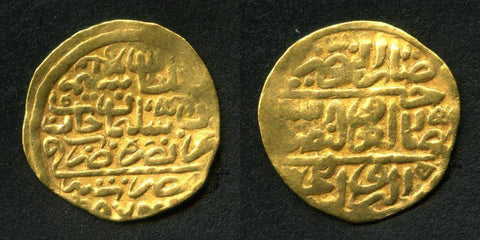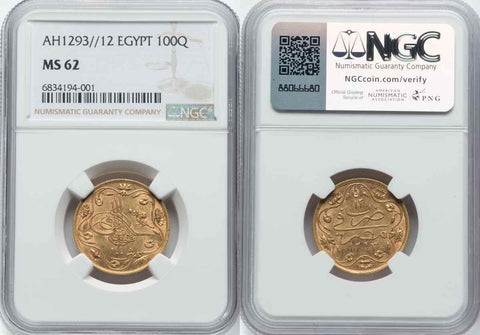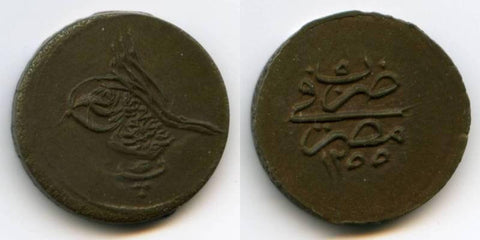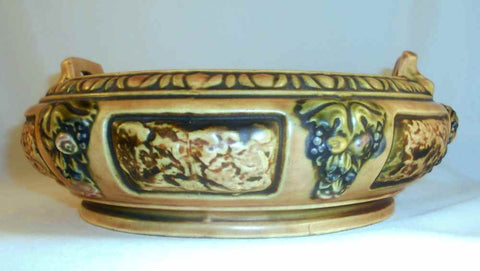Mamluk Ashrafi Gold Coin Cairo Egypt? 906-922 AH / 1501-1516 AD Al-Ashraf Abu Al-Nasr Qansuh II al-Ghuri
Description: A gold coin from the Mamluk sultan Qansuh II al-Ghuri (Al-Ashraf Abu Al-Nasr), who ruled Egypt and Syria during the period 906-922 AH (1501-1516 AD). Qansuh II al-Ghuri is from the Circassian Burji Mamluk dynasty. The Obverse of the coin is similar to the obverse of Balog #869 with a central Arabesque knot. However, the reverse is not similar to the reverse of Balog 869 and does not appear to have an equivalent on Balod's catalog. The obverse shows partially legible writing at the bottom of the obverse, which may be interpreted as being part of the word al-Qahira or Cairo suggesting the coin may have been struck in al-Qahira, current day Cairo the capital of Egypt. The coin clearly shows the sultan's name "Qansuh al Guhri" on the obverse. Please carefully review the scans as they are part and parcel of our description.
Date: Date off flan, struck in the period 906-922 AH (1501-1516 AD).
Mint: Most likely minted in Al-Qahira current day Cairo the Capital of Egypt.
Size and Weight: This is an Ashrafi, weighs ~3.3 grams and is ~14 mm in diameter. The Ashrafi is a standard 3.3 to 3.5 gram coin of high purity gold (over 22K) and standard weight minted after the Venetian ducats. This type of coin was established by Al-Ashraf Barsbay, who ruled from 1422-1438 AD and instituted monetary reform during his reign.
References: It is Album #1041 and its obverse is similar to the obverse of Balog #869. It is Wilkes 1072.
Condition: I would grade this coin as very fine or much better. The coin itself is much better than the photos suggest with very well defined and legible calligraphy. The coin has a few minor scratches, dings and wear commensurate with its circulated state. A definite quality coin worthy of a spot in your collection. Please see photos for additional condition information.
Historic Perspective: The word Mamluks in Arabic means "owned", hence their nickname "Slave Kings". They succeeded the Ayyubids and ruled Egypt and Syria for about 250 years. They had been recruited by the Ayyubids and then, like the Turkish mercenaries of the Abbasid caliphs, had usurped power from their enfeebled masters. Unlike their predecessors, however, they were able to maintain their power, and they retained control of Egypt until the Ottoman conquest in 1517. Militarily formidable, they were also the first power to defeat the Mongols in open combat in 1260, at Ayn Jalut near Nazareth in Palestine.%0d%0a%0d%0a<p>The Mamluk sultans are usually divided into two dynasties, the Bahris (1250 - 1382 AD), chiefly Turks and Mongols, and the Burjis (1382 - 1517 AD), chiefly Circassians. These names arise from the location of the barracks of the Mamluks within the city of Cairo (Al Kahira). Those originating from the barracks on an island in the Nile are Bahari (sea dwellers) and those who were in the towers are the Burjis (the tower dwellers). The Bahri sultans were usually selected from a few chief families, but during Burji times there was scant respect for hereditary principle in the selection of rulers. Neither dynasty was able to exercise more than a limited power over the turbulent Mamluk soldiers. The sultans reigned, on average, less than seven years and usually met violent ends. In spite of the dangers that threatened the sultans at home, they usually conducted a vigorous foreign policy. They defeated the last of the Crusaders and repulsed the Mongol invasion of Syria. At times they held all Palestine and Syria and the holy places of Arabia. Even after the Ottomans occupied Egypt they wheeled quite a bit of power until Mohammad Ali massacred the last of them at the Cairo Citadel in the early 1800's.





